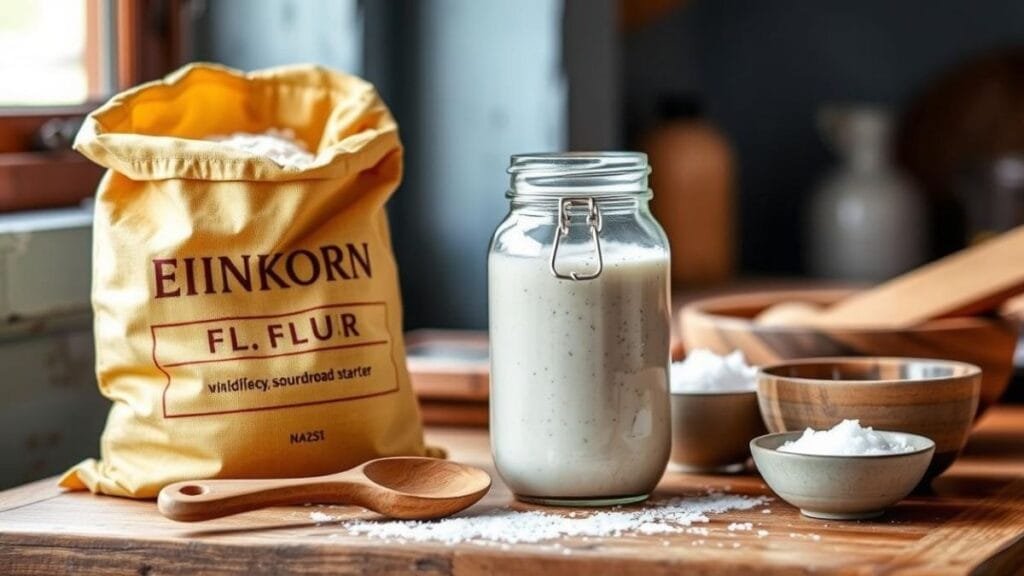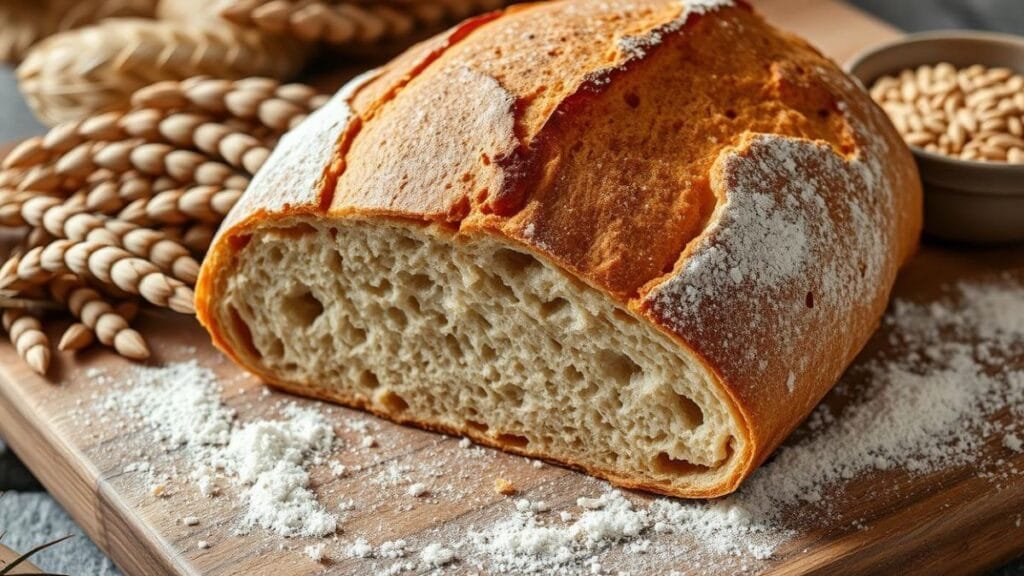Did you know einkorn wheat has only 14 chromosomes? This is compared to 42 in modern wheat. This ancient grain is changing how we view bread, nutrition, and baking.
I’m passionate about baking and have found the world of einkorn sourdough bread. It’s a nutritional powerhouse that connects us to ancient culinary traditions. This grain offers a special approach to fermentation and nutrition, unlike regular wheat.
Einkorn is more than flour; it’s a path to healthier, easier-to-digest bread. It has 16% to 18% protein, making it the highest protein wheat. It also has four times more beta-carotene than modern wheat and more B6 and zinc.
Exploring einkorn sourdough bread has changed my baking. Its nutty flavor and buttery yellow color make it special. Whether you’re health-focused or just love food, einkorn sourdough bread is a tasty and nutritious journey.
In this guide, I’ll share all you need to know about making perfect einkorn sourdough bread. We’ll cover its unique traits and how to ferment it to bring out its nutritional benefits.
Einkorn: The Ancient Grain Revolution
Einkorn is a fascinating journey into the world of heirloom wheat. It’s a remarkable alternative to modern grains. This ancient grain was first grown in the Fertile Crescent around 10,000 years ago. It brings a unique nutritional profile to artisanal bread making.
- Only two sets of chromosomes (compared to modern wheat’s 42)
- Never been hybridized
- Maintains original genetic qualities
What Makes Einkorn Unique
Einkorn is a wholesome ingredient with remarkable nutritional benefits. It has more protein, vitamins, and minerals than standard wheat. With 18% protein, it’s more nutritious than Emmer and Spelt.
Nutritional Powerhouse
Einkorn’s nutritional profile is impressive. A single slice offers essential nutrients:
| Nutrient | Amount | Daily Value |
|---|---|---|
| Calories | 112 | – |
| Protein | 4g | 8% |
| Fiber | 3g | 13% |
| Carbohydrates | 24g | 8% |
Gluten Content and Digestibility
Einkorn’s gluten content is different from modern wheat. It lacks the y-gliadin protein group, making it easier to digest for some. This makes einkorn a good option for those with mild gluten sensitivities.
While not a complete solution for Celiac disease, einkorn is a gentle alternative in artisanal bread. It connects us to our agricultural heritage through wholesome ingredients.
Essential Ingredients for Einkorn Sourdough Bread
Making the perfect einkorn sourdough bread begins with choosing top-notch ingredients. Einkorn flour, unlike regular wheat flour, gives your bread a special touch. Let’s look at the key ingredients that will elevate your baking.
The main ingredients for making tasty einkorn sourdough bread are:
- All-purpose einkorn flour
- Filtered water
- Sea salt
- Active sourdough starter
Einkorn flour is special because of its ancient grain roots. It has less gluten and more nutrients, making it perfect for bakers looking for something unique. Einkorn flour makes your bread softer and tastes more delicate than wheat flour.
If you want to boost the nutritional value, try adding sprouted grains to your recipe. Sprouted grains make the bread easier to digest and increase nutrient absorption, making it healthier.
| Ingredient | Quantity | Purpose |
|---|---|---|
| Einkorn Flour | 500 grams | Primary flour base |
| Water | 300 grams | Hydration and dough formation |
| Sourdough Starter | 100 grams | Fermentation and flavor development |
| Sea Salt | 10 grams | Flavor enhancement |
Your sourdough starter is vital in bread-making. It adds good bacteria and wild yeasts that enhance the bread’s taste and texture. Keeping your starter healthy is essential for consistently great einkorn sourdough bread.

Mastering the Einkorn Sourdough Starter
Creating a sourdough starter is like an art form. It connects bakers to ancient ways of making bread. My experience with einkorn sourdough starter has shown me the importance of patience and precision. These qualities are essential for creating a strong and tasty culture.
Creating Your Einkorn Starter from Scratch
To start an einkorn sourdough starter, you need simple ingredients and careful steps. I suggest using a specific ratio for feeding to help fermentation grow:
- Mix 39g of all-purpose einkorn flour
- Add 17g of water
- Combine with existing starter
- Keep the starter at a room temperature of 70-80°F
Maintaining a Healthy Starter
Feeding your starter regularly is key to its health. I feed my starter 4-12 hours before making dough. By the fifth feeding, it will be about 96% einkorn. This gives it a special flavor.
Signs of a Ready-to-Use Starter
A mature sourdough starter shows clear signs of being ready:
- Doubles in volume within 3-6 hours after feeding
- Shows consistent bubble formation
- Has a pleasant, slightly tangy smell
- Passes the “float test” – a small portion of starter floats in water
Watching your starter grow helps you understand its unique traits. It also improves your baking skills. Remember, each sourdough starter is a living thing that needs gentle care and attention.
Einkorn Sourdough Bread: Step-by-Step Process
Making einkorn sourdough bread is all about precision and patience. I’ll show you how to make a delicious loaf. This bread highlights the special qualities of einkorn, an ancient grain.
Ingredient Preparation
You’ll need four main ingredients for this einkorn bread recipe:
- 540g all-purpose einkorn flour
- 200g active sourdough starter
- 300g water
- 10g sea salt
Mixing and Autolyse
Start by mixing flour and water. Let it rest for 30 minutes. This step helps the flour soak up water, making the dough stronger and tastier.
Fermentation Process
Next, add the sourdough starter and salt. Mix gently. Let it rise for 3-4 hours at room temperature. It should grow by 20-30%.
| Stage | Duration | Temperature |
|---|---|---|
| Autolyse | 30 minutes | Room temperature |
| Bulk Fermentation | 3-4 hours | 68°F (20°C) |
| Proofing | 1-2 hours | Room temperature |
Shaping and Baking
Shape the dough carefully and put it in a banneton for proofing. Heat your oven to 500°F (260°C) for an hour. Bake at 450°F (232°C) for 40 minutes to get a golden crust.
Pro tip: Let the bread cool for at least 2 hours before slicing. It keeps well at room temperature for 2 days or in the freezer for a month.

Working with Einkorn Dough: Tips and Techniques
Making the perfect einkorn sourdough loaf is a journey. It teaches you about this ancient grain’s unique traits. Unlike modern wheat, einkorn flour needs special care and attention.
Understanding Hydration Levels
Einkorn flour absorbs water differently than other flours. It takes longer to soak up liquid. This means you’ll need to adjust your recipe.
I’ve found that einkorn needs up to 15% less liquid than regular wheat. This helps it absorb water better.
- Expect a stickier dough texture
- Reduce hydration levels slightly
- Allow extra time for liquid absorption
Proper Folding and Shaping Methods
Working with einkorn sourdough requires gentle handling. Its unique dough needs a soft touch during shaping.
| Technique | Key Considerations |
|---|---|
| Folding | Use light, careful movements to preserve dough structure |
| Shaping | Work quickly to prevent excessive gluten development |
| Rising | Expect slower rise (about half of traditional wheat dough) |
Troubleshooting Common Issues
Einkorn sourdough can be tricky, but knowing its quirks helps. Focus on these tips for a successful loaf:
- Rise slowly and patiently
- Score the dough lightly (no deeper than ¼ inch)
- Maintain lower hydration levels
- Use cooler temperatures during fermentation
Mastering einkorn sourdough takes time and practice. Each loaf teaches you more about this ancient grain’s baking magic.
Baking and Storage Recommendations
Making the perfect sourdough einkorn bread needs careful baking and storage. I’ll share my best tips for a delicious einkorn sourdough sandwich bread. It will stay fresh and tasty.
To bake your sourdough einkorn pitted bread, precision is key. Preheat your oven to 450°F (232°C). Get ready for a 40-minute baking journey. The goal is a perfect golden crust and a soft inside.
Optimal Baking Techniques
- Use a Dutch oven for even heat distribution
- Bake covered for first 30 minutes
- Uncover for final 10 minutes to crisp the crust
- Check internal temperature reaches 200-210°F
Storage Recommendations
| Storage Method | Duration | Best Practices |
|---|---|---|
| Room Temperature | 3-5 days | Store in bread box or sealed plastic bag |
| Freezer Storage | Up to 3 months | Slice before freezing, wrap tightly |
Pro tip: Always let your bread cool completely for at least one hour before slicing. This helps the crumb set and avoids a gummy texture. Store it at room temperature in a breathable bag to keep its texture and flavor.
Reviving day-old bread is easy. A quick toast or light oven warm-up can make it taste fresh again. This makes your sourdough einkorn bread great for any meal.

Conclusion
In this guide, we explored the world of einkorn sourdough bread. It’s different from modern wheat in many ways. Making einkorn sourdough sandwich bread connects us to ancient baking traditions.
When you add salt and care for your sourdough starter, you’re making more than bread. You’re creating a nutritional powerhouse. Einkorn flour has twice the phenolic acids of regular wheat flour. It also has anti-inflammatory properties, making it a healthier choice than commercial bread.
I suggest you try new things. Each loaf you make will be special, showing your skill and the beauty of einkorn grain. Whether it’s a fancy boule or a simple sandwich bread, you’ll be making something delicious and healthy.
Choosing einkorn means you’re not just baking. You’re keeping a culinary tradition alive and feeding yourself with a grain that has been around for thousands of years. Your baking adventure begins today.
Frequently Asked Questions
What is einkorn flour, and how is it different from regular wheat flour?
Einkorn flour comes from an ancient grain older than modern wheat. It has less gluten and is packed with more nutrients. This makes it a healthier choice than regular wheat flour.
Is einkorn sourdough bread suitable for people with gluten sensitivities?
Einkorn might be easier to digest for those with mild gluten issues. But, it’s not gluten-free. People with celiac disease should avoid it. Always talk to a doctor before changing your diet.
How long does it take to create an einkorn sourdough starter?
Making an einkorn sourdough starter takes 5-7 days. You need to feed it flour and water every day. This lets wild yeasts and bacteria grow. Be patient and consistent for a strong starter.
Can I use einkorn flour in all my regular bread recipes?
Einkorn flour is different from modern wheat flour. It needs special handling because of its lower gluten. You might need to adjust the recipe, like using less water and handling it gently.
What are the main nutritional benefits of einkorn sourdough bread?
Einkorn sourdough bread is full of nutrients. It has more protein, minerals like zinc and magnesium, and antioxidants. The fermentation process makes these nutrients even better for you.
How should I store my einkorn sourdough bread?
Keep your einkorn sourdough bread at room temperature in a paper bag or bread box for 2-3 days. For longer storage, freeze it after slicing. Always let it cool down before storing to avoid moisture buildup.
What makes the fermentation process of einkorn sourdough special?
Einkorn sourdough’s fermentation is special because of the ancient grain’s unique composition. This slow process breaks down gluten and phytic acid. It makes the bread more nutritious and easier to digest than quick-rise breads.
Can I use sprouted einkorn flour in my sourdough bread?
Yes, sprouted einkorn flour is great for sourdough bread. It has less phytic acid and more nutrients. It might make the bread sweeter. You might need to adjust the recipe for the right texture and rise.














